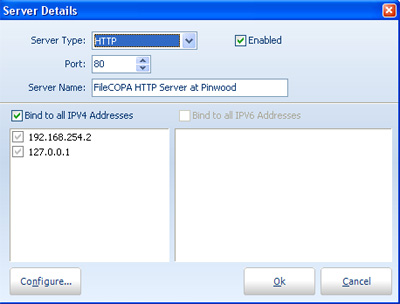This is a standard secure web server, using SSL for encryption. The standard port is 443.
There are some limitations, eg it does not support Server Side Includes or .htaccess files, but does link to PHP (which can of course link to SQL databases).
Click a Hotspot on the image below for further information.

Click a Hotspot on the image below for further information.

Virtual Hosts
The Web Servers (HTTP & HTTPS) support multiple virtual hosts, eg a single server running on port 80 can provide access to several web sites, eg www.myfirstdomain.com, www.myseconddomain.com, www.anotherdomain.net
If a visitor requests access to one of these domains, they will be given the appropriate pages. An unspecified request (eg to your IP Address or another hostname leading to your server, but which is not a specified Virtual Host) will access the files in the Document Root specified above.
First ensure you have a server setup on the servers tab.
Then, on the Users tab, add a user with the name of the Virtual Host (eg www.myfirstdomain.com), and set the Document Root to the location of the web site for this host, and ensure that access is only permitted to the appropriate server (HTTP or HTTPS). Also set this user not to require a password.
Go to http://windows.php.net/download/ Select the latest Thread Safe Installer, download and run the installer.
During install select Other CGI as the server type. This will ensure the php-cgi.exe file is installed. Existing installations of PHP might not include this, and you may have to remedy this, possibly obtaining it from a zipped version of PHP.
Now link FileCOPA to the php-cgi.exe file by selecting configure on the Server Details screen (see above).
The default path for PHP installation is usually c:\program files\php or c:\program files (x86)\php